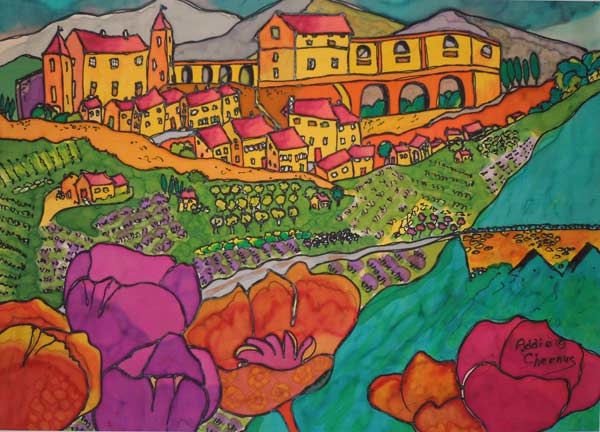
Addie Chernus paints on silk on location and loves it. There are at least three reasons why.
“It requires minimal materials,” says the Tahoe, California, artist. “I use just a tripod with a frame attached on top, which my husband designed. Then I use little plastic bottles I bought at REI to hold my dyes. I use one brush, a Chinese brush that is strong, inexpensive, has a point, and holds a lot of liquid.”

Chernus’s easel, which allows her to work vertical or horizontal. The silk is stretched on the frame and held by hooks.
Chernus says her Chinese brush gives her just enough versatility. “The point allows some degree of detail, but plein air is about the moment,” she says. “I want the impression, the feeling, what the area means to me, not detailed detail.”
Her surface is habotai silk, a lightweight, plain weave. She stretches it over a frame that grabs the strong silk fabric with hooks. Chernus uses Dupont dyes that are fixed onto the fabric through steam.

“Brugge,” by Addie Chernus, dye on silk
Chernus reports that the silk dyes act similar to a very wet watercolor mixture. “It’s very much like watercolor,” says the artist. “They brush on and mix beautifully on the silk, and dry within minutes. I don’t use a palette much — I mix the colors on the silk.”
This points to another advantage silk painting has outdoors — it is a medium for working fast, and a medium that dries quickly. Chernus says she took her silk-painting materials to Europe for four months, and she was able to wrap each silk painting in archival tissue, put them in a cotton bag for transport, and steam-set the colors months after the painting session.

“Sablet,” by Addie Chernus, dye on silk
An artist painting on silk has options when it comes to resists — a fluid that dries on the fabric and prevents the dye from affecting the area in which it is applied. A clear resist preserves the silk color, and when steamed, disappears from the fabric, leaving not so much as a wrinkle. A black resist steams away its viscous nature, but stains the silk black where it was applied, creating almost a stained-glass effect. “It’s like pen-and-ink and watercolor,” says Chernus. “I like the linear quality and the looseness. It’s a world in itself.”

“Gordes,” by Addie Chernus, dye on silk
Chernus says she greatly enjoys teaching silk painting, and that artists take rather quickly to the medium when she introduces it. “It’s a very old art form,” she says. “It has so many uses. You can take the fabric and make clothing, or wall hangings. It’s so exciting for plein air. It’s liquid, so you put it down quickly. You can rewet the surface, remove some color, add color, mix them.” She reports that unlike many media, silk paintings become more vibrant after the painting session and the steaming.

Chernus painting silk on location
The artist teaches and sells DVDs, but the silk paintings she did on her long trip to Europe aren’t for sale. She assembled the images in a book instead. “I won’t sell any of those,” Chernus says. “They are little boxes for my memories.”




